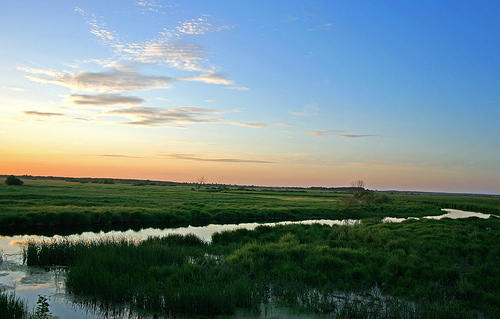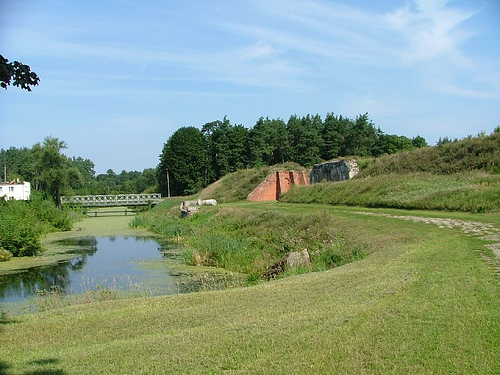

Location: Podlaskie Voivodeship Map
Area: 592 sq km (229 sq mi)
Biebrza National Park is a nature reserve in Podlaskie
Voivodeship in North- East Poland. It covers a biosphere of wetlands
and marches with an area of 592 sq km (229 sq mi) along a Biebrza
river. It was established in 1993 and it is the largest national
park in the country. The park contains a network of hiking trails
that reach a total length of over 500 km. Additionally there are 60
km of trails especially designed for biking. Biebrza river is also
open for exploration by kayaking and canoeing that can be rented
locally. It is inhabited by wolves, bears, foxes, roe deer, elks,
moose, beavers, otters and many others. However one of the most
dangerous mammals here are wild boars. Keep a distance from these
animals. Despite their cute appearance, these animals might be quiet
aggressive if humans decide to approach a group. Additionally there
are about 276 species of birds that nest here.
Don't forget
to visit Osowiec Fortress. It was constructed by the Russian army in
the end of the 19th century. Poland at the time was part of the
Russian Empire. It was heavily shelled by the Kaiser German Army
that reduced it to a pile of concrete blocks. Its ruins now contain
a museum of weapons that date back to World War II. Additionally
there is a population of bats that live in the underground
structures.
Osowiec Fortress

Position
It covers the Biebrza valley from the estuary of
Niedźwiedzica to the Biebrza and ending at the estuary of the
Biebrza to the Narew. Almost the entire Biebrza run is located
within the park (approx. 155 km). The protection of this area began
in the interwar years, creating two reserves: Red Marsh (existing to
this day with changed borders) and Grzędy.
History
1989 -
Thanks to the efforts of the Biebrza Society, the Biebrza Landscape
Park is established, covering the areas of the Biebrza basins -
lower and middle.
1993 - Transformation of the landscape park
into a national park.
1995 - The Park was entered on the list of
wetlands protected by the Ramsar Convention.
2010 - The Park is
included in its entirety in the IBA bird refuge list kept by
BirdLife International.
19–26 April 2020 - The fire consumed
approx. 5,280 hectares of the Park, which is approx. 9.5% of its
area. It covered a number of valuable natural areas, incl. in the
vicinity of the Red Swamp; the cause - drought and burning of
grasses. For over a week, almost two thousand firefighters, WOT
soldiers and rescuers fought the fire. Six fire-fighting planes and
two helicopters were used, which carried out nearly a thousand water
drops. The entire firefighting operation was financed from the state
budget, including the funds of the Ministry of the Environment and
the State Forests. Almost PLN 8 million was allocated for this
purpose. According to experts, arson was the cause of the fire. The
prosecutor's office discontinued the investigation due to the
failure to detect the perpetrators. Studies carried out after the
fire show significant declines in the population of 14 species of
birds, incl. aquatic warbler, buzzard, cricket.
Natural
values
In the Biebrza National Park there are water, marsh, peat
bog, rushes, as well as forest communities (alder, birch, riparian
forests). Particularly valuable is a large group of moss communities
containing numerous rare and relict species (low birch, Lapland
willow, royal gnidosz), disappearing in other parts of the country.
The plant cover is characterized by a great variety, a high
degree of naturalness and the presence of many rare species, such as
orchids (red orchid, common slipper, white thornbone, red
helleborine, broadleaf helleborine, one-sided taiga), sundew
(roundleaf sundew, long-leaved sundew), club moss (juniper sundew) ,
clove, wroniec).
In the Biebrza National Park there are 49
species of mammals, 271 species of birds, 36 - fish, 12 -
amphibians, 5 - reptiles. Invertebrates are represented by over 700
species of butterflies, 448 species of spiders, over 500 species of
beetles, 19 species of leeches and 42 species of birdworms.
Many bird species associated with the marsh environment nest in the
Biebrza Marshes. There are isolated breeding sites of boreal
species, as well as species whose geographical range center is in
the taiga and tundra zones. Moreover, the Biebrza Basin is of great
importance for many species of feeding and resting birds during
their annual migrations. Biebrza is one of the most important
refuges in Central Europe for waders requiring vast, wetlands.
The most characteristic breeding bird species are: ruff (visible
in the park emblem), aquatic warbler, snipe, great snipe, snipe,
curlew, daffodil, crane, white-winged and white-tailed tern, eagle
owl, lesser spotted eagle and mud owl.
The most
characteristic mammal of the Biebrza National Park is the moose, for
which the park is the largest refuge in Poland. Their number here is
about 400.
Tourist attractions
Rafting on the Biebrza
River
bicycle routes (103.7 km), including the Podlaski Stork
Trail and Green Velo
educational paths:
historical and natural
path "Góra Skobla"
nature path "Footbridge"
nature-historical
path "Around Fort IV Osowiec Fortress"
"Barwik" nature path
nature path "Grobla Honczarowska"
"Długa Luka" nature path
"Biały Grąd" nature path
nature path "Brzeziny Kapickie"
"Red
Swamp" nature path
natural path "Borek honey"
"Dunes" nature
path
"Forest" nature path
nature path "Szuszalewo"
nature
path "Szuszalewo - Nowy Lipsk"
Other tourist attractions:
Uroczysko Grzędy
Tsarist Road
Goniądz - the market square
Osowiec Fortress located in the area of Osowiec-Twierdza.